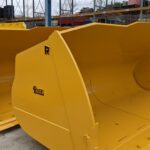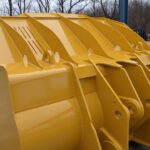Success Story: Rockland Manufacturing Invests in Training to Prepare Workforce for Change in Production Flow
Rockland Manufacturing Co., located in Bedford, PA with approximately 250 employees, is a medium-sized manufacturer of bulldozer blades, loader buckets, beach cleaning equipment, and land clearing equipment. Rockland primarily serves the crushing, aggregate, and log loading markets.
Rockland was beginning to implement a major change to their long-established production methods. In fact, the current flow had been in place for well over 30 years. The major change was to create a combined production method/department from two formally standalone functions. The change required changes in supervision, ERP tracking, production planning and scheduling, and manufacturing engineering processes.
The change is driven by the need to improve efficiency, specifically by reducing the amount of handling and transportation of certain products. By combining production functions for several of their product lines, both assembly and finish welding functions will be accomplished at the same workstation. Formally, a product would be assembled at one location in the plant, then transported by overhead crane to be staged at the second location until that department had capacity to work on it.
Rockland had already conducted experiments to prove that the change to the production flow would be successful in improving efficiency, but since the change had far-reaching affects throughout most departments within the entire company, management felt that specific training of key stakeholders was needed to help build unified momentum for implementation and asked IMC to provide this training.
The Rockland management team, while in consultation with IMC Business Advisor, Tim Davis, expressed concern about meeting project goals and objectives since the front-line production workers and their direct supervisors were accustomed to years of the current state workflow processes. Many organizations entering significant operational change are very good at getting the proper capital requirements and soft costs calculated and controlled, the weakest link is often underestimating the human side of change. As such, IMC proposed a Change Management training initiative that would complement the capital investment already being made.
Tim Davis expressed, “This training is essential, it is beyond the capital equipment, renovation, and other costs normally associated with significant change, it can make or break the change effort including the need to extend timelines and adjust milestones when employee teams struggle through the transition.”
The IMC team helped Rockland identify key personnel who had responsibility and direct impact on the change requirements. Additionally, the team investigated the organizational requirements compared with the current state of the supervisors and other key personnel to identify gaps and develop a program specifically designed to help the Rockland team navigate a successful transition.
A highly customized change management training initiative was deployed by the IMC. It focused on how to anticipate the implications of change, how to monitor and adapt to change, how to communicate through it, and how to keep changing and improving. This training included interactive exercises to help the participants be more comfortable with the new changes to their workflow, break down potential barriers to implementing change by improving communication, and really focus on the importance of positive changes in production. All customized to align with the requirements for a successful transition to the new process.
Impressed with the results, the Rockland management team reported that the training provided by the IMC was successful in helping their workforce understand the need for change in their production methodology. Particularly, they pointed out that communication about the change improved. The interactive exercises conducted by IMC in the training helped break down communication barriers and improved teamwork. The momentum for moving forward with the production change was achieved, and since then the new assembly/weld function is established and becoming an accepted part of the company’s culture.
“We’re very pleased with the results of the training. It was a great way to break the ice regarding a systemic change in one of our oldest and most experience facilities. By training on change management, discussing the benefits of the change, and how to properly communicate the outcomes of the change, we experienced much less of the typical resistance to change that one usually experiences in any business environment. The project was done faster, with less effort, much less drama, and most importantly, we haven’t had any trouble with making the change stick over time. We’re now building more, more efficiently, together, than ever before.” Bo Pratt, President, Rockland Manufacturing Co.


